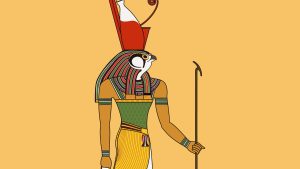Horus: The Falcon-Headed God of Ancient Egypt
Horus is one of the most significant and widely venerated gods in ancient Egyptian mythology. Depicted as a falcon or a man with a falcon’s head, Horus was associated with the sky, kingship, and protection. His name is often translated as “The One Far Above” or “The Distant One,” reflecting his role as a sky god.
Origins and Mythology
Horus’s mythology is deeply intertwined with the story of Osiris, his father, and Isis, his mother. According to legend, Osiris, the god of the afterlife, was murdered by his brother Set, who wanted to usurp his throne. Isis, Osiris’s wife, gathered his scattered remains and resurrected him long enough to conceive Horus. After his birth, Horus was hidden and raised in the Nile Delta to protect him from Set.
As Horus grew, he became determined to avenge his father and claim his rightful place as king. This led to a series of epic battles between Horus and Set, known as the “Contendings of Horus and Set.” These battles, representing the struggle between good and evil, lasted for many years. Eventually, Horus emerged victorious, symbolizing the triumph of order (Ma’at) over chaos.
Symbolism and Associations
Horus is most famously associated with the Eye of Horus, also known as the “Wadjet” eye. The Eye of Horus is a symbol of protection, healing, and royal power. According to the myth, during his battles with Set, Horus lost one of his eyes, which was later restored by the god Thoth. The Eye of Horus became a powerful amulet in ancient Egypt, believed to protect against evil and ensure health and safety.
Horus was also considered the divine protector of the pharaohs, who were often regarded as his earthly incarnation. The pharaohs adopted the title “Son of Horus,” and many temples and monuments were dedicated to him across Egypt.
Worship and Temples
Horus was worshiped throughout Egypt, but his most significant cult center was in Edfu, where the grand Temple of Horus stands. This temple is one of the best-preserved in Egypt and remains a major tourist attraction today. It was built during the Ptolemaic period and is filled with intricate carvings and reliefs depicting the god’s mythology.
Forms of Horus
Horus was worshiped in various forms, each representing different aspects of his character:
- Horus the Younger (Horus the Child): Known as Harpocrates in Greek, this form depicts Horus as a young child with a finger to his mouth, symbolizing childhood and innocence.
- Horus the Elder: Represented as a powerful and mature deity, this form is associated with kingship and the sky.
- Horus Behdety: Worshiped as a solar god, particularly in the Nile Delta, often associated with the sun god Ra.
Conclusion
Horus is a multifaceted deity, embodying themes of kingship, protection, and the eternal struggle between order and chaos. His mythology and symbolism were central to ancient Egyptian religion and culture, influencing everything from royal titles to funerary practices. As a god of both the sky and the kings, Horus represented the link between the divine and the earthly realms, ensuring the protection and continuity of the Egyptian state.




